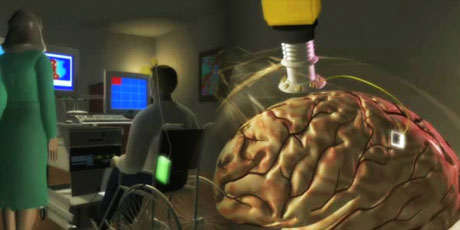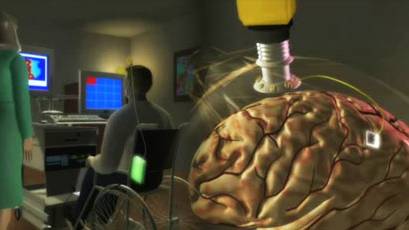Brain Machine Interfaces
Source: innovationwatch.com

Modifying the human body or enhancing our cognitive abilities using technology has been a long-time dream for many people. Nano-bio-info-cogno-synbio (NBICS) is now reaching a critical stage where it could lead to the fulfillment of that dream.
An increasing amount of research tries to link the human brain with machines allowing humans to control their environment through their thoughts. It is said: "Ultimately the technology will be used for people whose spinal cords are destroyed in accidents or those handicapped by strokes." (1)
Scientists demonstrated in 2002 that human thoughts can be converted into radio waves and used by paralyzed people to create movement. (1) "Scientists in Australia have developed a mind switch that enables people to activate electrical devices (e.g. turn on a radio or open doors) by thinking."
The IDIAP Research Institute (formerly the Institute Dalle Molle d'Intelligence Artificielle Perceptive/Dalle Molle Institute for Perceptual Artificial Intelligence) is developing non-invasive brain machine interfaces.
The Institute states in a recent publication: "Brain activity recorded non-invasively is sufficient to control a mobile robot if advanced robotics is used in combination with asynchronous EEG analysis and machine learning techniques. Until now brain-actuated control has mainly relied on implanted electrodes, since EEG-based systems have been considered too slow for controlling rapid and complex sequences of movements. We show that two human subjects successfully moved a robot between several rooms by mental control only, using an EEG-based brain-machine interface that recognized three mental states. Mental control was comparable to manual control on the same task with a performance ratio of 0.74."
Many researchers are working on brain machine interfaces.
Cyberkinetics Neurotechnology Systems, Inc. of Foxborough, Massachusetts, received FDA approval to test the "Brain Gate." The company started with people with spinal cord injuries and is now recruiting patients for BrainGate ALS trials, according to deal.com.
Researchers at Duke University Medical Center in Durham, North Carolina, are developing a wireless neuroprosthetic that could potentially be used to control robotic limbs for quadriplegics. Dr. Miguel Nicolelis of the university’s Department of Neurobiology has a variety of articles on his webpage. A 14 year-old boy plays space invaders using thoughts alone, as a grid connected to his brain measures his electrocortigraphic activity.
The device was developed by Dr. Eric C. Leuthardt, an assistant professor of neurological surgery at the School of Medicine, and Dr. Daniel Moran, assistant professor of biomedical engineering at Washington University in St. Louis. They connected the patient to a sophisticated computer running a special program known as BCI2000 developed by collaborator Gerwin Schalk at the Wadsworth Center, New York State Department of Health in Albany, which displays a video game linked to an electrocorticographic (ECoG) grid. The primary purpose of the grid was to facilitate treatment for epilepsy.
In Austria, the Graz University of Technology has a brain-computer interface lab. In Japan, Hitachi has joined forces with university researchers. In Finland the Proactive Computing Research Programme (PROACT) is funded by the Academy of Finland and led by Academy Professor Mikko Sams. IST has funded the Presencia project under its Fifth Framework Programme - Future Emerging Technologies - Presence Research.
A 'Berlin Brain-Computer Interface (BBCI)' -- a 'mental typewriter' -- was unveiled at the 2006 CeBIT in Germany, the biggest consumer technology conference worldwide. Devices such as the BBCI are not only seen to benefit disabled people but "could also spread to the entertainment industry, creating a whole new class of video games. Or they could be integrated in active car safety systems, for instance braking the vehicle in response to the driver’s thoughts."
Cambridge Consultants' Virtual Helmet can link brain wave patterns to a virtual reality system, allowing the wearer to enter an illusory world of movement. Researchers at Nippon Telegraph & Telephone Corporation in Japan have developed galvanic vestibular stimulation -- a technology that can compel a person to walk along a route in the shape of a giant pretzel, in effect creating remote-controlled humans.
Researchers at Columbia University have combined the processing power of the brain with computer vision to develop a novel device that allows people to search through images ten times faster than they can on their own. The cortically coupled computer vision system -- known as C3 Vision -- turns the brain into an automatic image-identifying machine. The project is funded by the US Defense Advanced Research Projects Agency. The Air Force has long been interested in "alternative control technology" that will allow its pilots to fly planes hands-free.
A robotic hand controlled by the power of thought alone has been
demonstrated by researchers in Japan. It mimics the movements of a person's real hand, based on real-time functional magnetic resonance imaging of brain activity. This is seen as another landmark in the advance towards prosthetics and computers that can be operated by thought alone.
The system was developed by Yukiyasu Kamitani and colleagues from ATR
Computational Neuroscience Laboratories in Kyoto, and researchers from the
Honda Research Institute in Saitama. Subjects lying inside an MRI scanner were asked to make "rock, paper, scissor" shapes with their right hand. The scanner recorded brain activity and fed data to a connected computer. After a short training period, the computer was able to recognise the brain activity associated with each shape and command the robotic appendage do the same.
The list goes on.
A brain-activity interpretation contest organized by the University of Pittsburgh provided entrants with functional MRI scanner data and behavioural reports recorded when four people watched two movies. Competitors were asked to create an algorithm that used the brain activity to predict what viewers were thinking and feeling as the film unfolded.
The crunch test came from a third film. Competing researchers were shown the brain activity only, and had to predict the behavioural data -- what the viewers had reported seeing and feeling during the film on a moment-by-moment basis. The rules are here and the results are here.
The competition webpage can be found here. It describes next year’s competition as follows: "The 2007 PBAIC will build upon last year, but will push the competition to a much higher level by focusing on interpretation of subjects' actions and behaviors in addition to cognition. The 2007 Pittsburgh Brain Activity Interpretation Competition will involve analysis of a new, unique fMRI data set representing dynamic subject-driven behavior in a virtual world. fMRI data will be made available from multiple subjects in a very realistic virtual world of multiple streets and rooms (house, bar, playground) with subject control in the world, multiple tasks, social interaction, rewards and threat avoidance. Additionally, eye movement data will be provided along with overlaid tracking of every object fixated on by subjects in the virtual world."
The Choice is Yours
Although brain–machine interfaces are often talked about in relation to disabled people, we can expect they will also be used by the non-disabled as a means to control their environment -- especially if the devices are non-invasive and no implants are needed.
To date there has not been much public discussion of the implications of brain machine interfaces, the amount of public R&D funding they receive, and control, distribution and access to these devices.
Gregor Wolbring is a biochemist, bioethicist, science and technology ethicist, disability/vari-ability studies scholar, and health policy and science and technology studies researcher at the University of Calgary. He is a member of the Center for Nanotechnology and Society at Arizona State University; Member CAC/ISO - Canadian Advisory Committees for the International Organization for Standardization section TC229 Nanotechnologies; Member of the editorial team for the Nanotechnology for Development portal of the Development Gateway Foundation; Chair of the Bioethics Taskforce of Disabled People's International; and Member of the Executive of the Canadian Commission for UNESCO. He publishes the Bioethics, Culture and Disability website, moderates a weblog for the International Network for Social Research on Diasbility, and authors a weblog on NBICS and its social implications.
Resources
Please contact the author for information on this reference or for additional future references at gwolbrin@ucalgary.ca






















